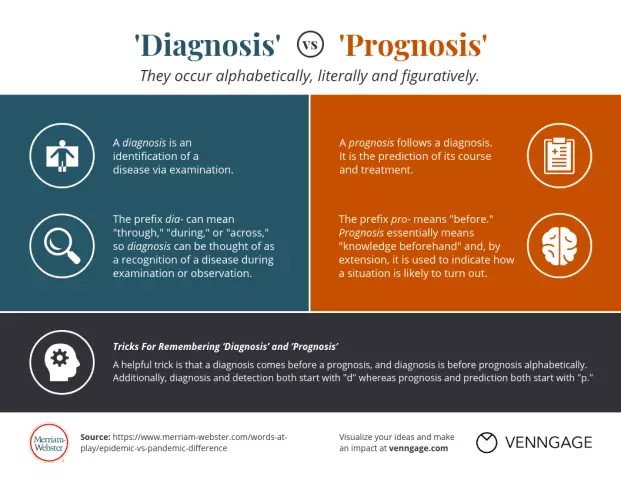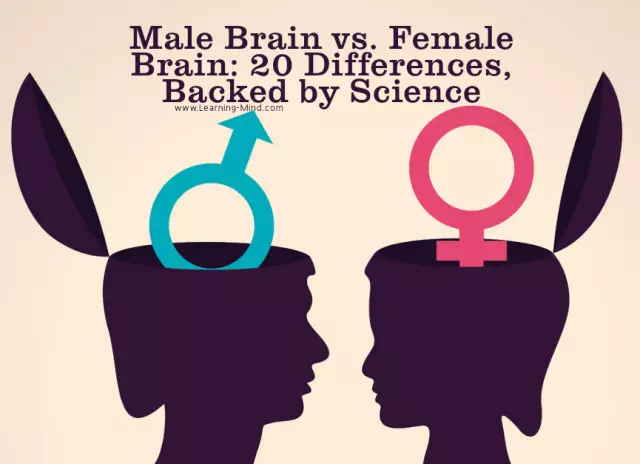- Author Rachel Wainwright [email protected].
- Public 2023-12-15 07:39.
- Last modified 2025-11-02 20:14.
Gliosis
Gliosis is the process of replacing deformed or lost tissues of the central nervous system with glial cells (neuroglia).

According to the localization and the nature of the growth of glial cells, they are divided into the following types of gliosis:
- Anisomorphic - the growing glial fibers are randomly located;
- Fibrous - glial fibers are more pronounced than cellular elements of glia;
- Diffuse - covers large areas of the brain, spinal cord;
- Isomorphic - the growing glial fibers are located relatively correctly;
- Marginal - glial fibers predominantly grow in the intrathecal areas of the brain;
- Perivascular - glial fibers are located around sclerosed inflamed vessels;
- Subependymal - glial fibers are formed in the areas of the brain located under the ependymus.
A special mechanism for replacing destroyed tissues, gliosis, develops in nerve tissues as a result of damage to their structural units - neurons, replacing them with growing glial cells. By expanding, these cells isolate lesions, protecting intact tissues. In simple terms, gliosis can be compared to a scar or scar on the tissues of the central nervous system.
The types of cells that make up the central nervous system:
- Neurons are the main cells that generate and transmit impulses;
- Ependyma - cells lining the central canal of the spinal cord and ventricles of the brain;
- Neuroglia (glia) are auxiliary cells of the nervous tissue that make up 40-50% of the volume of the central nervous system. There are 10-50 times more glial cells in nerve tissues than neurons. Their function is to protect and restore nerve tissues after infections and injuries, as well as to ensure the work of metabolic processes in the central nervous system.
The proliferation of glial cells occurs in the form of the formation of foci of gliosis at the site of damage. The amount of gliosis is a specific value calculated from the ratio of enlarged glial cells to the rest of the central nervous system cells per unit volume. The quantitative indicator of gliosis is a value that is directly proportional to the amount of damage healing in the body.
Gliosis foci
Foci of gliosis are pathological growths of clusters of glial cells that replace destroyed neurons.
The appearance of foci of gliosis is a consequence of such pathological processes and diseases:
- Multiple sclerosis;
- Tuberous sclerosis;
- Inflammation - encephalitis of various origins;
- Epilepsy;
- Hypoxia;
- Birth trauma;
- Prolonged hypertension;
- Chronic hypertensive encephalopathy.
To identify foci of gliosis, it is necessary to conduct magnetic resonance imaging, according to the results of which it is possible not only to determine the dislocation of foci of gliosis and their size, but in some cases even obtain information about the age of formation. This makes it possible for a neuropathologist, in conjunction with other types of research and clinical examination, to find out the result of which active or postponed process of CNS lesion is this focus of gliosis.
Gliosis may, without manifesting itself clinically, be discovered by chance when examined for other indications. You should know that the conclusion of MRI "signs of gliosis" is not a diagnosis, but a reason to undergo a comprehensive medical examination by a specialist neurologist. With any result of such an examination, it is not necessary to treat the focus of gliosis, but the disease that caused its appearance.
Brain gliosis
Gliosis of the brain is a disease caused by a hereditary pathology of fat metabolism, leading to damage to the central nervous system. It is quite rare. It is caused by a mutation of the gene responsible for the synthesis of hexoseaminidase A, an enzyme involved in the metabolism of gangliosides. Accumulating in the cells of the central nervous system, gangliosides disrupt their work. The type of inheritance is autosomal recessive, therefore, the probability of conception exists if the carriers of the mutant gene are both parents, and in this case it is 25%.
The most common hereditary Tay-Sachs disease is a consequence of genetic pathology, mainly as a result of the conception of a child by close relatives. A newborn with cerebral gliosis develops normally during the first months of life; by 4-6 months, a regression occurs in physical and mental development. Hearing, vision, the ability to swallow are lost, convulsions occur, muscles atrophy and paralysis occurs. The maximum life expectancy of children with brain gliosis is 2-4 years.
Gliosis treatment
You need to know that gliosis cannot be treated, since it is not an independent disease, but a consequence of various pathological processes. Having found gliosis, the cause is treated in order to avoid the development of new foci of gliosis.
In the presence of foci of gliosis, preventive measures should be taken to avoid their growth. First of all, it is necessary to stop eating fatty foods in large quantities, since it is detrimental to the brain. A large amount of fat entering the body damages and kills the neurons that regulate body weight. Already after 7 months of food oversaturated with fats, the number of such neurons decreases significantly, and foci of gliosis grow, replacing dead neurons.

In the case of a hereditary disease of fat metabolism, there is no specific treatment for brain gliosis. At 18-20 weeks of gestation, a diagnosis can be made based on the results of the analysis of the amniotic fluid. If the fetus has a disease, it is necessary to terminate the pregnancy.
The main thing in the prevention of gliosis is a healthy lifestyle and regular examinations by specialists. It is impossible to treat gliosis, but it is really possible to prevent or suspend.
YouTube video related to the article:
The information is generalized and provided for informational purposes only. At the first sign of illness, see your doctor. Self-medication is hazardous to health!






